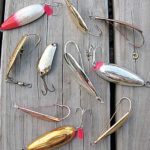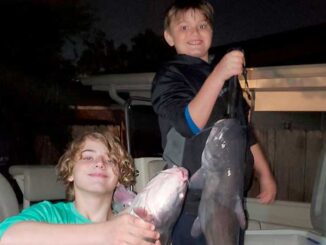
Gold and silver are the bait, not the target, of this Lafitte treasure hunt.
Redfish are tearing up spoons in Lake Salvador,” the voice said on the other end of the phone. The inflection in the voice made it both a statement and an implied question.
Personally, I love to catch reds on a spoon, so I answered without hesitation.
I met the voice, which belonged to Capt. Mike Daigle (504-915-9480), at the dock of Cochiara’s Marina in Lafitte just after sunrise, where he, Garry LeBlanc and I boarded Daigle’s 24-foot SeaPro, and headed toward Lake Salvador.
The crisp early morning air felt cold — too cold for only the long-sleeve shirt I was wearing. It reminded me that summer was really gone for another year, and I’d better get used to packing a jacket for these chilly morning runs.
The trip to Lake Salvador is not very far, and it was mere minutes before Daigle motored the big bay boat through Bayou Villares and into Lake Salvador, where we planned to spend the morning trolling and casting spoons for redfish.
Daigle turned south and idled slowly to within a long cast from the shoreline, killed the outboard and dropped the trolling motor over the bow.
“There’s a lot of grass in here in this shallow water,” he said, “but the reds have been pretty thick in here the past several days. I think they’re still hanging around the area. We’ll troll and drift and cast a while, and see if we come up with something.”
Daigle said that over the previous days, the best action was coming from silver spoons.
“The reds have definitely been showing a preference for silver lately,” he said. “You’ll catch them on gold spoons and spinners and soft plastics, too, but silver spoons have been out-fishing everything else here lately.”
Fortunately, Daigle had let that cat out of the bag the day before, and I’d made a quick run to the tackle store to stock up on weedless silver spoons. I bought a couple of each in ¼-, ½- and ¾-ounce sizes, and chose to tie on the biggest one, a ¾-ounce shiny silver weedless Johnson Silver Minnow.
Daigle was also tossing a silver spoon, his a Johnson Sprite, a model that trails a treble hook, and LeBlanc was tossing a tried-and-true gold spoon. If the reds wanted spoons, we were covering all the bases.
But it was, indeed, the silver spoon that drew first blood, and it was my weedless model at that! It was a big, heavy spoon, so I used a medium-speed retrieve with a slight twitch now and then, and a hefty, greedy bronzeback found it irresistible.
He stretched my line for the better part of five minutes before I wrestled him back to the boat, and Daigle netted and weighed him at 7 pounds. We put him on ice for the grill.
Daigle had some trouble keeping the grass off the treble hook on his spoon, and he switched to a glow/chartreuse soft plastic that still attracted no attention. Then he switched to a silver weedless spoon, and the reds pounced on it.
LeBlanc cut the gold spoon off his line, tied on a silver weedless and then he got into the action as well. Daigle was right — they wanted silver, so silver we gave them!
The shoreline at that section of Lake Salvador is cluttered with trees and logs, and the grass on the bottom is clustered in spots. The reds often followed our spoons from their haunts in the grass to right up to the boat, where they either grabbed the baits and ran or turned away.
The action was steady for a while, but seemed to dwindle to nothing, and Daigle decided to make a short run over to the Christmas Trees. Only pilings are what’s left of the Christmas Trees, where a former erosion-fighting program used pilings and netting to hold old discarded Christmas trees. The attempt proved ineffective, and rocks now line the shoreline to prevent Lake Salvador from breaking through to the Bayou Segnette Waterway.
Trout and reds often show up along the remaining structure, but we trolled along the pilings there and then along the adjoining rocks with nary a nibble, and then returned to the area we started at first.
“They’re in the grass,” Daigle said. “They’re scattered, but they are hanging in the grass, and we’ll just have to keep working our spoons. We’ll put some more fish in the box.
“I find that once you commit to fishing Lake Salvador, you should just stay and work it thoroughly. The temptation is to pick up if it’s slow and head to a whole different area, but I try to resist that temptation and keep working around Salvador until I find them.
“If the water is good, you have some current and see signs of bait in the water, stay. Switch baits, switch colors, but stay, and generally, your patience will pay off.
“If you absolutely can’t resist the temptation to leave, then I’d suggest either heading to the Pen or Bayou Perot or Bayou Rigoletts. Look for bait in the water, because if you find the bait, you’ve found the fish. I usually look for shrimp boats, because if they are working the area, I know there’s bait in the water.”
I snagged my heavy silver spoon on a submerged log and broke it off, due both to the log and a frayed line. So, I tied on a gold ¾-ounce weedless spoon, and this time I tied a 6-inch leader to a barrel swivel above my spoon using 25-pound monofilament. I figured that would not only help with the fraying but it would reduce all the line twisting.
The reds ate it up! Go figure! They slammed the silver spoons early, but now were showing a definite preference for the gold color. That reminded me that, whenever you’re on a good bite and it dies off suddenly, instead of leaving that spot that has been so productive, try switching baits or colors. Switch to a curl-tail instead of a paddle tail, or use a larger bait or jighead or a smaller one. Or just try a different color. Sometimes that’s all it takes.
We were definitely back in the action again, and the hefty reds gave us a great workout.
Right now is the time to grab a handful of both gold and silver spoons, and try spoonin’ in Salvador. You might be rewarded with both specks and reds.
Capt. Mike Daigle can be reached at (504) 915-9480.




